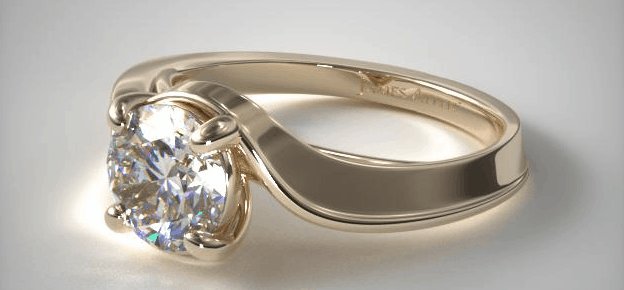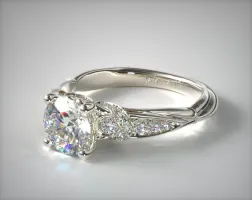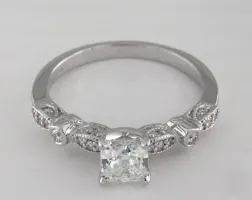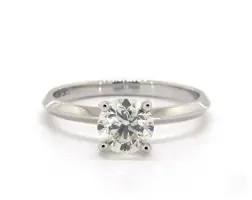14K Vs. 18K Gold: Which is Better?
Learn how to balance quality and value to find the best gold for your jewelry
Learn how to balance quality and value to find the best gold for your jewelry
Whether you’re shopping for an engagement ring online or offline, you’ve probably noticed that most settings are available in two different types of gold — 14K and 18K.
What’s the Difference Between 14K and 18K Gold?
Pros and Cons of 14 Karat and 18 Karat Gold: Which is Better?
14K Gold vs. 18K Gold: Which Should You Buy?
In the United States, most engagement rings are made from 14 karat (14K) gold. However, it’s also common for certain engagement ring settings to come in 18K gold. While these two types of gold can look similar, they actually have several major differences.
Below, we’ve explained these differences, as well as what you should know if you can’t decide between 14K and 18K gold for an engagement ring, necklace, bracelet, pair of earrings or any other fine jewelry.
Are you looking to sell your gold? This article is geared towards helping people looking to purchase jewelry. If you are looking to sell your gold, feel free to hop on over to our Selling Your Jewelry page. If you are looking to sell your diamond engagement ring, we have a specific article for Selling Your Diamond Ring
This email will go to our contact at Abe Mor who has helped thousands of our readers sell their gold and diamond jewelry. They consistently offer the highest prices for our readers' jewelry. Please include the weights and details of the jewelry. Images are helpful as well.
$0
ValueThis is the current wholesale price of gold. When selling gold you receive a percentage of the price. We recommend asking Abe Mor for a quote as they have consistently offered the highest percentage to our readers.
Get an Offer
Contrary to popular belief, when you buy a piece of gold jewelry, it usually isn’t made out of pure gold. Instead, almost all gold jewelry is made from an alloy created by combining pure gold with a variety of other metals.
The reason for this is that pure gold is very soft. If engagement rings, earrings and other jewelry were made using pure gold, they’d scratch, scuff, dent and warp extremely easy, often just from brushing against another surface.
There’s also the color issue — instead of the warm gold color that most of us associate with gold jewelry, pure gold is actually closer to orange in color.

Because of this, modern gold jewelry uses gold that’s mixed with other metals. The purity of this gold is measured using the karat system, which provides information on what percentage of any type of gold is made up of pure gold.
Gold karatage is expressed in parts out of 24. For example, pure gold is 24K, as all 24 out of 24 parts consist of pure gold.
18K gold consists of 18 parts pure gold mixed with 6 parts other metals. Depending on the color of the gold (for example, white gold, yellow gold or rose gold), these metals could include nickel, silver, copper, zinc and palladium. Expressed as a percentage, 18K gold is 75% pure gold.
14K gold, on the other hand, consists of 14 parts pure gold mixed with 10 parts other metal, with the other metals varying based on the gold’s color. Expressed as a percentage, the pure gold in a piece of 14K gold jewelry accounts for 58.3% of the total metal.
According to Hobart M. King, PHD in geology, the overwhelming majority of gold is used for jewelry. Roughly 10% is used by governments for coinage and reserves. 12% is used for consumer electronics.
14K and 18K gold are both commonly used for engagement rings — in fact, they’re both highly popular options for engagement ring settings. Both have their own unique pros and cons, from appearance to cost, durability and more. We’ve listed these below.
14K gold has several advantages. First, it’s affordable. Because pure gold makes up 58.3% of the metal content of 14K gold, an engagement ring made from 14K gold will usually cost slightly less than the same ring made from 18K gold.
For example, this 2mm solitaire engagement ring from James Allen costs $560 when 14K gold is chosen as the metal. In 18K gold, the exact same ring from James Allen costs $680.

Second, 14K gold is fairly durable. Gold is quite a soft, malleable metal that scratches, bends and warps easily. This means that the purer a gold engagement ring is, the easier it becomes to scratch it on door frames, desks, tables, the ground and other surfaces.
While 14K gold isn’t as durable as platinum or palladium, it’s more than durable enough for the average person. It’s also significantly more durable than 18K gold, making it the better choice if your fiancé-to-be has an active lifestyle or works with her hands.
Third, while 14K gold isn’t as pure as 18K gold, its relatively high pure gold content means that it retains the warmth and rich color that people associate with gold. Although it can look slightly dull when compared side-by-side with 18K gold, 14K gold looks stunning on its own.
Finally, 14K gold is ubiquitous and widely available in the world of engagement rings. It’s by far the most popular type of gold for engagement rings, accounting for about 90% of all rings sold in the US, UK and other Western countries. This makes it an easy option to find.
14K gold is popular for a reason: for most people, it’s the best choice. However, it does have a few small disadvantages.
First, to some people, 14K gold isn’t quite as aesthetically pleasing as 18K gold. Although it has a rich and impressive color, the appearance of 14K gold isn’t quite as strong as that of 18K gold due to its lower gold purity level.
Second, although it’s unlikely with either type of gold, 14K gold is slightly more likely to result in skin allergies than 18K gold. If your fiancé-to-be is allergic to silver, copper, nickel, zinc, or iron, this could be a point in 18K gold’s favor.
18K gold’s biggest advantage is its purity. As the purest form of gold that’s practical to use in an engagement ring, an 18K gold ring offers the gorgeous appearance of near-pure gold with most of the practical benefits of an alloy.
This extra purity can be especially obvious with 18K yellow or rose gold, which tends to show a warmer, more vibrant tone in 18K than in 14K gold.
The higher purity level of 18K gold also makes it less likely to trigger skin allergies than 14K or 10K gold. Although 18K gold still contains nickel and other alloy metals, they’re only present in small quantities, making the risk of contact dermatitis or other allergic reactions very small.

Unfortunately, 18K gold’s biggest advantage — its purity — is also its biggest disadvantage. Due to its higher percentage of pure gold, 18K gold is quite noticeably softer and easier to scratch or dent than 14K gold.
This means that if your fiancé-to-be works with her hands or has an active lifestyle, an 18K gold ring might not be the best choice.
Another disadvantage of 18K gold is its price. As we briefly mentioned above, 18K gold costs a fair amount more than 14K gold, with most 18K gold engagement rings priced at 150% to 200% as much as their 14K counterparts.
14K and 18K gold can both be excellent metal choices for an engagement ring, although each is best for a different type of person.



If your fiancé-to-be is highly active or works with her hands, a 14K gold engagement ring will be a better choice. Not only will it be more durable than an 18K ring, but it will also cost slightly less while still looking absolutely stunning. Joey King’s engagement ring is in yellow or rose gold and even though we don’t know if it’s a 14K or 18K gold, it looks simply amazing.
As we mentioned above, 14K gold is used in about 90% of all engagement rings sold for these reasons — it’s great looking, affordable and durable.
If you’re not concerned about durability and want the purest form of gold that’s still practical for an engagement ring, 18K gold can be a better choice. Just be aware that this type of gold can and often does scratch easily, meaning your fiancé-to-be will need to be more careful.
Finally, if your fiancé-to-be has a nickel allergy, 18K gold is a better choice than 14K gold, as it’s less likely to trigger contact dermatitis.
Need help choosing the right ring? From different types of gold to diamonds and more, contact us for free, personalized advice. Our experts can help you find the highest quality engagement ring or other jewelry for your tastes and budget.




Before you buy a diamond, get personal buying advice from industry veterans. We'll help you get the best diamond for the money.
DISCLAIMER: We don't use your email for marketing. Period.
Buying a diamond is confusing. On the surface, it seems like nothing makes sense. Take a look at this 2 carat diamond from James Allen and compare it
We’ve visited and reviewed many diamond retailers, online and offline. In the process, we’ve come across several diamond engagement ring vendors
1ct round cut petite side-stone diamond ring in yellow gold from Blue Nile A wide range of 1 carat diamonds exist both in online markets and local
Please enter your email address to receive your personal one-time use unique coupon code:
Here is your coupon code: GFDSF3GF